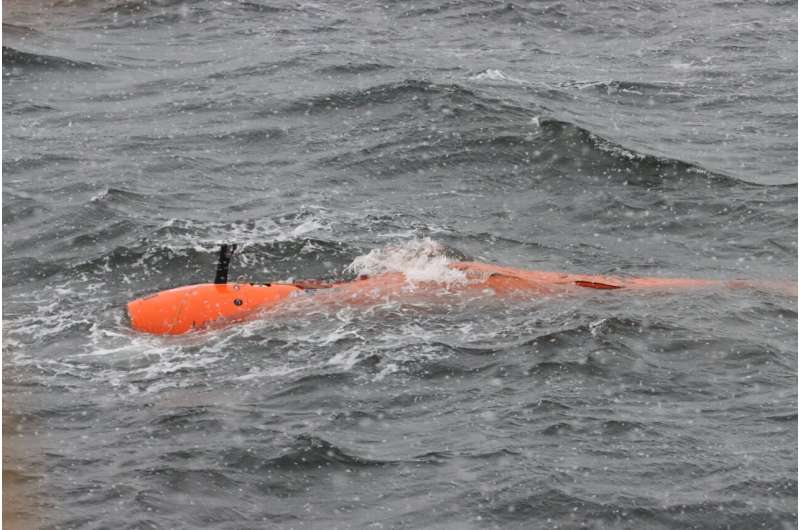This article has been reviewed according to Science X's editorial process and policies. Editors have highlighted the following attributes while ensuring the content's credibility:
fact-checked
trusted source
proofread
Underwater unmanned vehicle missing under Doomsday Glacier

The unmanned underwater vehicle Ran has gone missing under a glacier in Antarctica. The vehicle, owned by the University of Gothenburg, is one of just three in the world that is used for research and has contributed to important knowledge about the so-called Doomsday Glacier.
The seven-meter-long Ran disappeared this weekend during an expedition with the South Korean icebreaker RV/IB Araon. The project is led by Professor Anna Wåhlin, who is one of six participants on board from the University of Gothenburg. Ran is an unmanned underwater vehicle (AUV) packed with modern technology and sensors that can measure and document the surroundings in the water. It has the capacity to carry out long missions under ice, and has been used successfully in Antarctica, among other places.
Second visit
"This was the second time we took Ran to Thwaites Glacier to document the area under the ice. Thanks to Ran, we became the first researchers in the world to enter Thwaites in 2019, and during the current expedition we have visited the same area again. Even if you see melting and movements in the ice from satellite data, from Ran we get close-ups of the underside of the ice and information about exactly which mechanisms are behind the melting," says Wåhlin.
The Thwaites Glacier in Antarctica is gigantic and is sometimes called the Doomsday Glacier because it has the potential to raise global sea levels by several meters if it were to melt completely. Ran's measurements received a lot of attention, not only among polar scientists.
Losing contact with Ran
During her dives under the 200–500 m thick ice, Ran does not have continuous contact with the research vessel. The route is programmed in advance and thanks to its advanced navigation system, Ran can find her way back to open water. What it looks like under a glacier is often completely unknown. A mission under a glacier is therefore built up in several stages, which starts near the bottom and outside the ice to gradually build up the difficulty and finally go really close to the ice and perform measurements in the interface layer between ice and water.
During January of this year, Ran completed several successful dives under Thwaites, but during the last planned dive of the expedition, something went wrong. After a long journey under the ice, the AUV did not appear at the programmed rendezvous point. RV/IB Araon aborted the homeward journey and searches were conducted with acoustic search equipment, helicopters, and drones, without success. In the end it was just a matter of realizing that Ran had been lost.
Strong support from colleagues
"It's a bit like looking for a needle in a haystack, but without even knowing where the haystack is. At this point, Ran's batteries are dead. All we know is that something unexpected happened under the ice. We suspect it ran into trouble, and then something prevented it from getting out," says Wåhlin.
Wåhlin is grateful for the support her team has received from the expedition management and points out that no fault has been committed by the ship, which, on the contrary, has provided outstanding service to Ran and the team.
Risky research
"The data we receive from Ran is unique in the world, and of great value for international research. At the same time, the stakes are high, we knew something like this could happen, even that it's a likely end for Ran. Personally, I'm of the opinion that this is a better end than having the AUV aging gathering dust in a garage. At the same time, it is of course a very big loss. We have had Ran for five years now, and during those five years we have carried out about ten expeditions, training, development work and tests."
Even if the craft is lost, a unique resource in the form of knowledge and well-trained personnel remains in the organization. There is also peripheral equipment, a system for receiving and launching from large ships, spare parts, computers and analysis equipment.
"Our aim is to replace Ran. We will be looking for a financier to cover the deductions made by the insurance company and the price increase that has occurred over the years," says Wåhlin.
Provided by University of Gothenburg




















